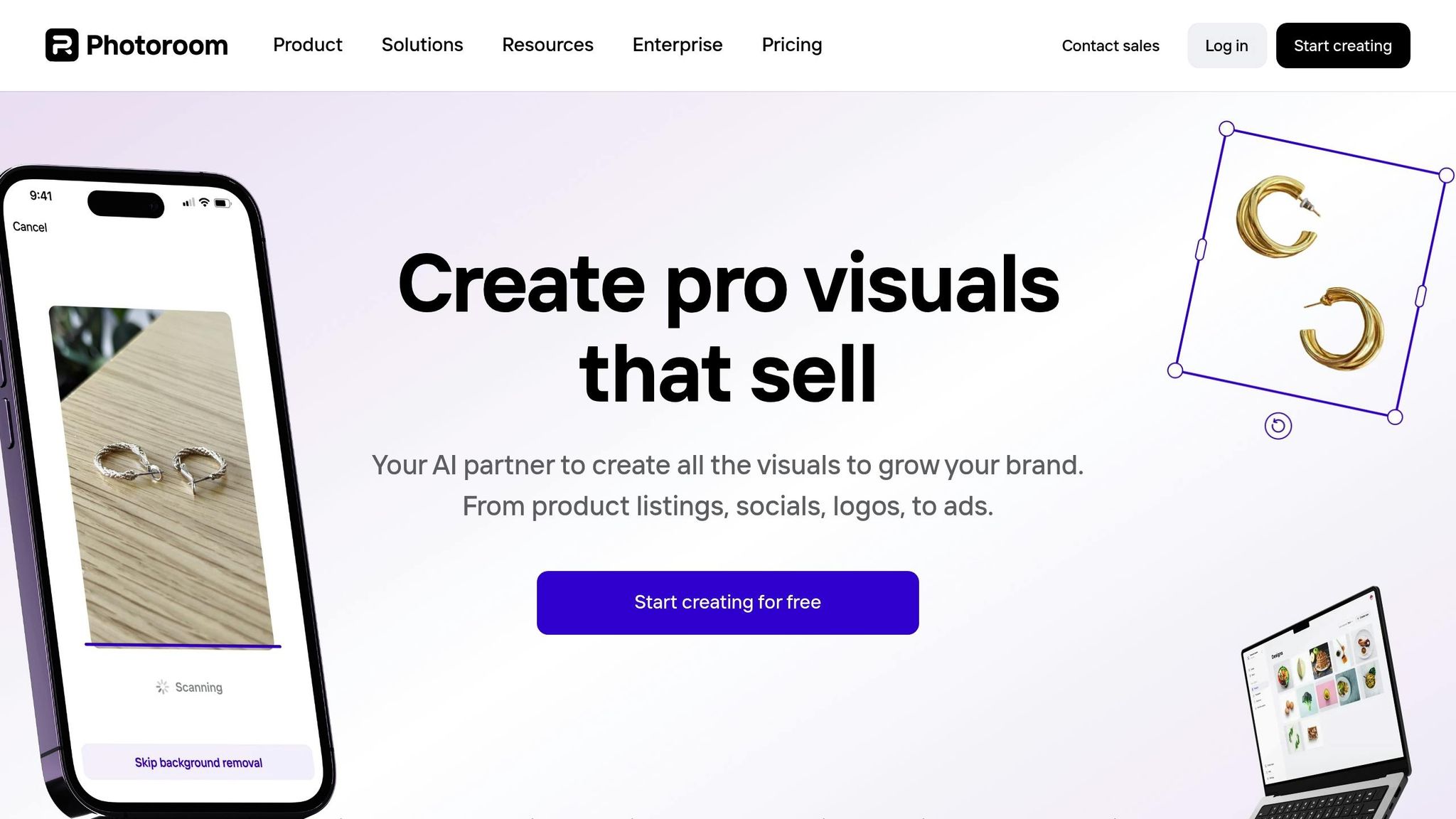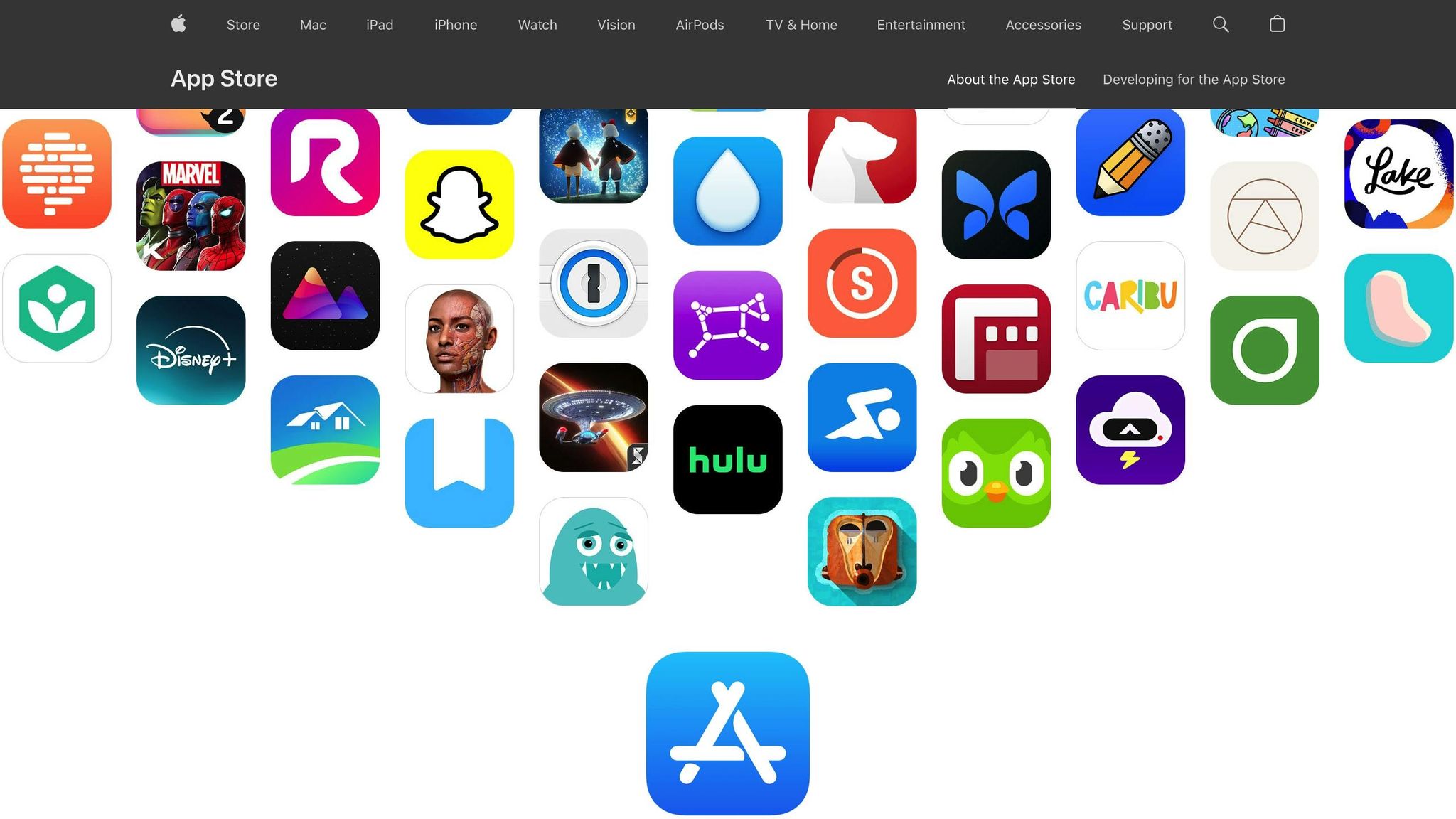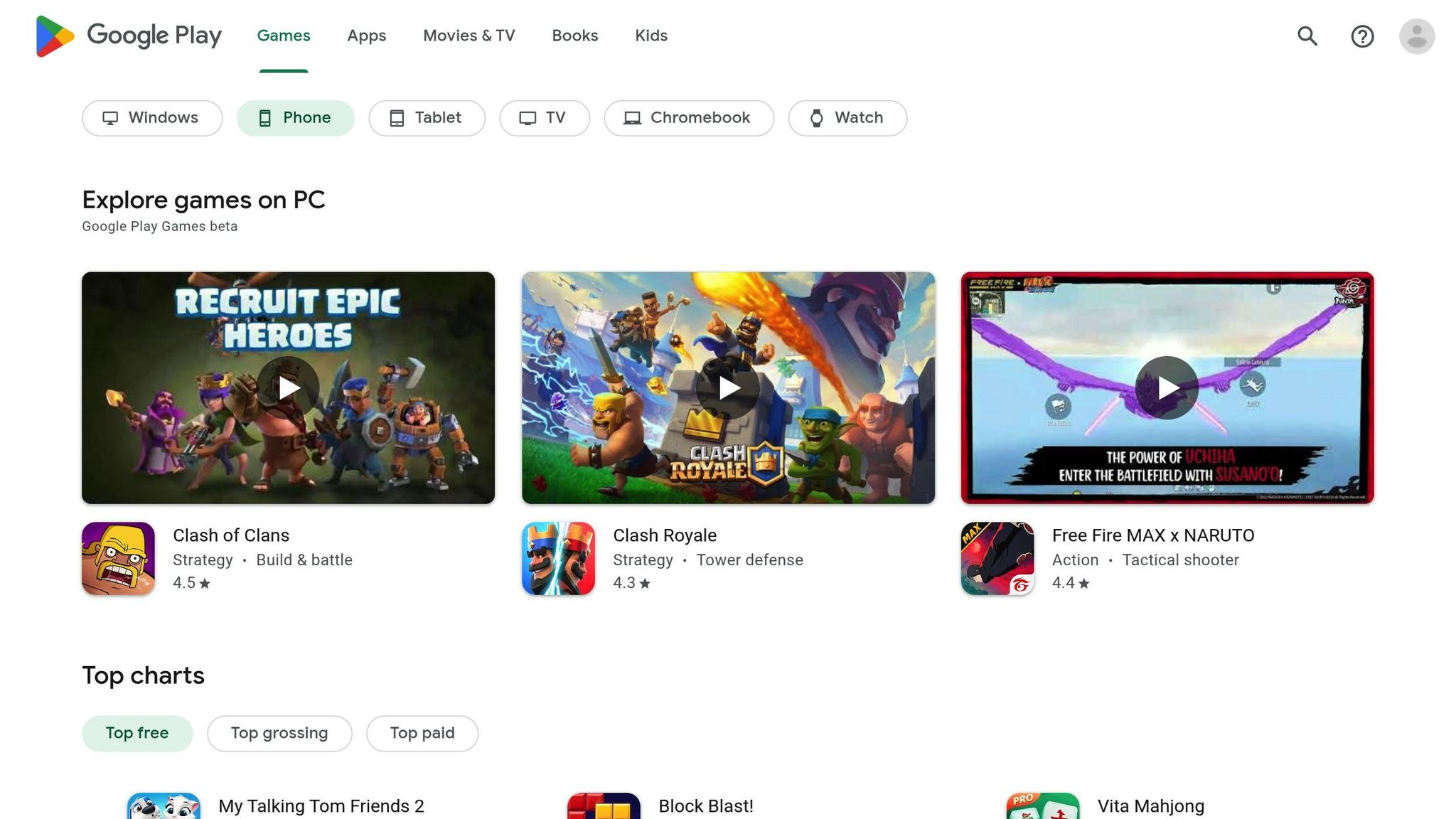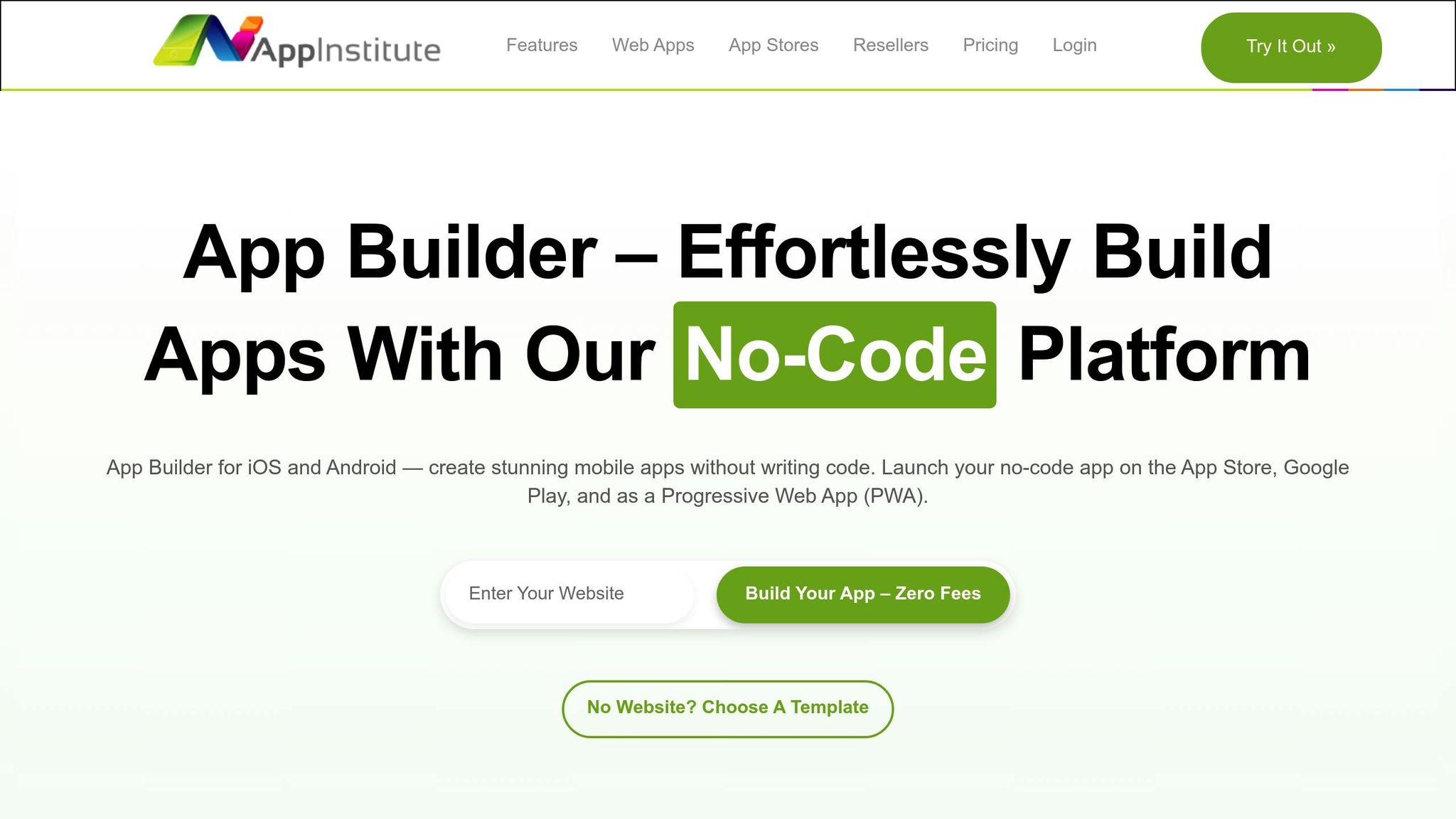When deciding where to launch your no-code app – iOS or Android – the choice depends on your goals and audience. Here’s a quick breakdown:
- iOS is better for apps targeting higher-income users, offering premium services, or relying on subscriptions. U.S. iPhone users have higher average incomes ($53,251 vs. $37,040 for Android) and spend more on apps ($10.40/month vs. $1.40/month). However, Apple’s stricter app review process means longer approval times.
- Android is ideal for reaching a larger, global audience, especially in markets where affordability is key. It’s also faster to launch on Android due to its flexible submission process. However, Android users tend to spend less, making ad-based or freemium models more effective.
Quick Comparison:
| Factor | iOS | Android |
|---|---|---|
| U.S. Market Share | 57.68% | 42.06% |
| Average Income | $53,251/year | $37,040/year |
| Monthly App Spend | $10.40 | $1.40 |
| Global Reach | 28% worldwide | 71% worldwide |
| Best Monetization | Subscriptions, premium apps | Ad-supported, freemium |
If revenue is your goal, start with iOS. If reach is more important, Android is the way to go. Many successful apps eventually expand to both platforms for maximum growth.
How to Succeed on iOS vs. Android – Matt Rouif, Photoroom: Sub Club Podcast


User Demographics and Market Share Analysis
Taking a deeper dive into market share insights, it’s clear that user demographics play a pivotal role in platform selection. The distinct characteristics of iOS and Android users in the United States create unique opportunities for app developers, especially when it comes to engagement and monetization strategies.
iOS: Younger, Wealthier, and High-Spending Users
In the U.S., iOS commands a 58.68% market share, translating to about 155 million users as of 2025. What sets iOS apart is its appeal to a younger, affluent audience.
For instance, 79% of Gen Z smartphone users in the U.S. prefer Apple, and 88% of teenagers in the U.S. use iPhones in 2025. These numbers highlight a generational trend favoring iOS, suggesting its stronghold may persist as these users grow older.
Among adults aged 18–34, iOS leads with 44% market share, compared to Android’s 30%. Gender trends also lean slightly toward iOS, with 31% of women choosing iPhones versus 28% of men. Additionally, geographic data shows that younger, wealthier, and more urban populations gravitate toward iPhones, while Android finds greater adoption in rural areas where affordability holds more sway.
Engagement is another area where iOS users stand out. On average, iPhone users spend 4 hours and 54 minutes on their devices daily, significantly more than Android users, who average 3 hours and 42 minutes. This higher engagement translates into more frequent in-app interactions and potentially increased monetization opportunities.
Android: Broad Appeal and Global Reach
While Android holds a 41.03% share of the U.S. smartphone market, representing around 100 million users, its advantages lie in its versatility and broader appeal to diverse income groups.
Android users are typically more price-conscious. In fact, 62% of both Android and iPhone users cite price as their primary factor when upgrading, though Android users often opt for more budget-friendly devices. This price sensitivity also influences app spending, as Android users are less likely to make significant in-app purchases.
However, Android’s broad income range makes it an ideal platform for apps targeting mass-market audiences. Additionally, Android users are more receptive to push notifications, which is a valuable trait for apps focused on regular re-engagement. The platform even boasts a 30.5% app conversion rate, slightly edging out iOS’s 30%.
For apps offering premium services, subscriptions, or higher-priced products, iOS users’ higher disposable income and spending habits make them a prime target. Conversely, if your app relies on advertising revenue or a freemium model that thrives on a large user base, Android’s diverse and cost-conscious audience provides ample growth opportunities. Understanding these demographic and behavioral differences can help align your app’s strategy with the right platform to maximize engagement and revenue.
Development and App Store Submission Process
Launching a no-code app on iOS and Android involves different steps, timelines, and considerations. Here’s a closer look at how each platform’s submission process can shape your app’s journey to market.
iOS: Apple App Store Requirements

Apple’s App Store is known for its rigorous review process, designed to ensure apps meet high standards for security, privacy, and quality. While this can add layers of complexity, it also ensures a polished user experience.
Apple organizes its submission guidelines into five categories: Safety, Performance, Business, Design, and Legal. Each section outlines specific criteria your app must satisfy. For example, your app must provide clear functionality, include complete metadata, and have accurate feature descriptions.
The review process itself is thorough. Apple’s team evaluates everything from your app’s core functionality to its compliance with privacy policies. This makes extensive testing for crashes and bugs essential before submission, alongside ensuring all metadata and app details are accurate.
If your app includes user registration or restricted areas, Apple requires a demo account for testing purposes. This allows their reviewers to access and evaluate all features without restrictions.
To simplify the process, platforms like AppInstitute can convert your no-code app into the required format, handling metadata and compliance. This can be especially helpful given that the iOS submission process tends to be more demanding compared to Android.
Android: Google Play Store Flexibility

The Google Play Store offers a more streamlined and flexible submission process, making it a popular choice for first-time app publishers. Its less restrictive approach provides more room for experimentation in both app design and submission.
Android apps rely on Android App Bundles, a system that automatically generates and delivers optimized APKs for different devices. This simplifies the challenge of supporting various screen sizes and specifications. Additionally, all Android apps must be digitally signed before they can be installed.
One of Google Play’s key advantages is its faster approval timeline. Automated systems handle much of the initial screening, with human intervention reserved for flagged apps or policy concerns. This often results in apps going live within hours or days, unlike Apple’s longer review process.
Google Play also allows alternative distribution methods. You can release your app directly through your own website, though this requires managing financial transactions independently since you won’t have access to Google Play’s in-app billing system.
AppInstitute can simplify Android submissions by automating tasks like app bundle generation, digital signing, and submission, aligning with Google Play’s efficient approval process.
Deciding Between iOS and Android
Choosing between iOS and Android often depends on your priorities. iOS offers a more premium environment but comes with stricter guidelines and a longer review process. On the other hand, Android’s speed and flexibility make it a quicker option for getting your app to market. With over 2 million apps on the App Store and Android commanding 71.85% of the mobile OS market share, both platforms offer significant opportunities depending on your app strategy.
Revenue Opportunities on iOS and Android
When choosing a platform, revenue potential is just as important as development ease. Your decision will shape how you monetize your app, as iOS and Android offer distinct strategies and outcomes.
iOS: More Revenue Per User
iOS users are known to spend significantly more on apps compared to Android users. On average, iOS users spend $10.40 per month, while Android users spend just $1.40. In 2024, global app revenue reached $150.1 billion, with iOS commanding 68% of that total, leaving Android with 32%. For perspective, the App Store generated $85.1 billion in 2023, compared to Google Play’s $47.9 billion.
Subscription-based apps see particularly strong performance on iOS. Average revenue per user (ARPU) for subscriptions is $8.39 on iOS, while Android lags behind at $1.54. Similarly, one-time purchases generate $12.77 per app on iOS, compared to $6.19 on Android .
Even in advertising-supported apps, iOS leads with an ARPU of $0.77, nearly double Android’s $0.35. iOS also outperforms in mobile ad click-through rates, achieving 3.2% compared to Android’s 1.6%. These spending patterns highlight iOS’s focus on premium user experiences, making it ideal for apps targeting higher-paying customers.
Android: Broad Reach with Ad-Based Revenue
Android’s strength lies in its massive user base, which supports a volume-driven revenue model, particularly through ads. Globally, 98% of Android’s free app revenue comes from advertising. Additionally, Android boasts a higher customer retention rate at 91%, compared to iOS’s 86%.
Android’s diverse ecosystem allows for flexible pricing strategies, and high-end Android users can exhibit spending behaviors similar to those of iOS users. In the gaming sector, freemium models thrive on Android, with in-app purchases and ads serving as key revenue drivers. However, Google’s more relaxed payment system requirements can sometimes result in billing challenges, a drawback compared to iOS.
Looking ahead, both platforms are set to grow. The App Store is projected to hit $161 billion in revenue by 2026, while Google Play is expected to reach $72 billion. Consumer spending forecasts for 2024 show $124 billion on the App Store versus $58 billion on Google Play.
These figures underscore the importance of aligning your monetization strategy with your platform choice. iOS is better suited for premium apps and recurring revenue models, while Android excels in reaching a broader audience through ad-supported approaches.
sbb-itb-539ae66
iOS vs Android: Side-by-Side Comparison for No-Code Builders
Building on earlier insights, here’s a clear breakdown of how iOS and Android stack up for no-code app builders. Each platform has its strengths, catering to different app goals and monetization approaches.
In the US, iOS leads with 57.68% market share, while Android trails at 42.06%. iPhone users in the US not only earn more but also spend significantly more on apps compared to Android users. Among younger adults (18–29), a striking 68% use iPhones, making iOS an attractive option for apps targeting this age group.
The development experience also varies significantly. iOS has stricter review processes, resulting in higher rejection rates, while Android offers a more lenient and faster review timeline. Here’s a closer look at the key differences:
Comparison Table: Key Factors
| Factor | iOS | Android |
|---|---|---|
| US Market Share | 57.68% | 42.06% |
| User Income (Average) | $53,251 annually | $37,040 annually |
| Monthly App Spending | $10.40 per user | $1.40 per user |
| Revenue Per App | $12.77 average | $6.19 average |
| App Review Time | Days to weeks | Hours to days |
| Rejection Rate | ~30% of submissions | Lower rejection rate |
| Primary Age Group | 18–29 (68%) | 35+ (majority) |
| Best Monetization | Subscriptions, premium | Ad-supported, freemium |
| Global Reach | ~28% worldwide | ~71% worldwide |
When it comes to monetization, iOS stands out for subscription-based models, capturing 67% of global app spending. The average in-app purchase on iPhones is about $1.07, compared to $0.43 on Android. This makes iOS ideal for premium apps and recurring revenue streams. Meanwhile, Android’s 71% global market share gives it an edge in volume, making it better suited for ad-supported and freemium models.
Geography also plays a major role. iOS dominates in affluent markets like the US, UK, and Japan, offering access to higher-spending users. Android, with its massive global reach, thrives in emerging markets, where affordability drives adoption.
Interestingly, recent data suggests a shift in the US, with some Android users moving to iOS, highlighting the growing appeal of iOS among higher-income consumers.
Choosing between iOS and Android ultimately comes down to your priorities: iOS offers higher revenue per user but requires more time and effort during development, while Android provides faster deployment and access to a broader, global audience with lower per-user spending.
Platform Selection Guide for US No-Code App Launches
Choosing the right platform is a crucial step when entering the US market with your no-code app. The insights below are designed to help you align your platform choice with your business goals and audience preferences, ensuring a well-informed decision.
Choosing Based on Goals
Prioritize iOS if revenue is your main objective. iOS users are known for spending more on apps, which makes this platform ideal for subscription-based services, premium tools, or apps aimed at higher-income groups. With iOS’s strong presence in the US and its user base’s purchasing behavior, it’s a natural fit for premium revenue models.
Opt for Android if reach is your priority. Android’s vast user base makes it a great choice for apps relying on ad-supported or freemium models. While individual spending on Android tends to be lower, its wide adoption favors apps like social platforms, games, or content-driven tools. Moreover, Android users are generally more open to ad-based experiences, which can be a key monetization strategy.
From a development perspective, iOS’s streamlined ecosystem allows for quicker releases, while Android’s diverse range of devices may require additional testing to ensure compatibility.
AppInstitute’s platform makes it possible to deploy on both iOS and Android, so your initial decision doesn’t limit your ability to expand or update your app later.
Future Expansion Strategies
Once your app is live, expanding to additional platforms in a phased manner can help you grow effectively. Start by focusing on one platform to refine your app, then scale based on user feedback and market response.
For apps with a premium revenue model, beginning with iOS can help you attract a high-value audience. Once you’ve validated the model and established strong revenue per user, expanding to Android can help you tap into a broader user base and explore additional monetization strategies, such as in-app advertising.
Alternatively, starting with Android can be a smart choice if your goal is to test demand across a wide range of devices. Once you’ve gained traction, transitioning to iOS allows you to introduce premium features and subscription options to an audience more inclined to spend.
Keep in mind that platform-specific optimizations may be necessary during expansion. Features that resonate with iOS users might require adjustments to appeal to Android users, and vice versa. AppInstitute’s drag-and-drop editor and templates make it easy to deploy across platforms without additional development work.
To safeguard your investment, AppInstitute offers robust data export options, ensuring your user data and content remain accessible. This flexibility allows you to avoid vendor lock-in and smoothly transition to other platforms if needed.
When planning your budget, consider both the App Stores plan, which costs $99/month and supports deployment on iOS and Android, and additional expenses like marketing, user acquisition, and customer support for each platform.
For those looking to test their app concept with minimal upfront costs, a Progressive Web App (PWA) strategy can be a great alternative. AppInstitute’s Instant plan lets you launch your app via web browsers, providing a cost-effective way to validate your idea before committing to full native deployment.
Conclusion: Making the Right Choice with AppInstitute

Deciding between iOS and Android for your no-code app launch doesn’t have to be complicated. Both platforms bring distinct strengths to the table, catering to different business goals and audience needs in the US market.
iOS stands out for revenue-driven apps. iPhone users tend to spend more on apps and services, making iOS the go-to choice for premium apps, subscription models, and paid services aimed at higher-income audiences.
Android shines when reach and scale are key. With its widespread adoption, Android is ideal for businesses prioritizing user acquisition, particularly for ad-supported or freemium apps.
Thankfully, technical challenges that once made platform selection daunting are now a thing of the past. AppInstitute’s no-code platform simplifies the process, removing the complexities of native development. It also ensures compliance with both Apple and Google regulations, while their in-house submission team takes care of the heavy lifting for you.
Here’s what one customer had to say about their experience:
"I just want to say how happy we are with the App Institute app builder… Great customer service too. Thanks for this great service! Would def recommend." – Daniel Harrison, AppInstitute Customer
No matter your starting point, your platform choice doesn’t lock you into a single path. Whether you begin with iOS to target high-spending users or launch on Android to reach a broader audience, AppInstitute’s flexibility allows you to expand to additional platforms as your app grows. Plus, the 30-day free trial gives you a chance to test your idea risk-free before committing.
Ultimately, your initial platform decision is just the first step. Successful apps often flourish on both platforms over time, with the starting point serving as the foundation for growth and validation in the ever-expanding mobile ecosystem.
FAQs
What should I consider when deciding whether to launch my app on iOS or Android first?
When deciding between iOS and Android for your app launch, it’s important to start with your target audience. In the U.S., iOS users typically have higher disposable incomes, making it a strong option for apps focused on premium features or subscription-based services. Meanwhile, Android dominates in global market share, making it a better choice if your goal is to reach a broader, international audience.
You’ll also need to weigh your budget and development resources. Developing for iOS can be more straightforward since there are fewer device variations to account for. In contrast, Android development often requires testing across a wide range of devices, which can add to your costs and development time.
Lastly, evaluate the platform’s monetization potential and app review process. iOS apps generally see higher revenue per user, but Apple’s review process is known to be more stringent. Android offers greater flexibility in this area, though you might need to invest extra effort to ensure your app works seamlessly across diverse devices. Carefully consider these factors and align them with your app’s objectives to choose the platform that best meets your needs.
What are the differences in monetization potential between iOS and Android apps?
When it comes to making money from apps, iOS apps typically bring in more revenue per user. In the United States, iOS users are known to spend more on app purchases and in-app features, which makes it an attractive platform for developers who want to maximize their earnings.
On the flip side, Android dominates the global market share, with over 70% of smartphone users worldwide. While Android users generally spend less per person compared to iOS users, the platform’s massive user base can help apps gain a wider audience – perfect for those aiming for mass adoption.
So, if your main focus is on profitability, iOS might be the smarter pick. But if your goal is to reach as many users as possible, Android could be the way to go.
What challenges might I face when submitting my app to iOS compared to Android?
Submitting an app to iOS tends to be more challenging because of Apple’s strict guidelines. The review process often takes more time, and apps can be rejected for reasons like not meeting policy requirements or leaving out essential details, such as metadata. On the other hand, Android offers a submission process that’s usually faster and more lenient. However, developers often face hurdles like device fragmentation, which requires ensuring the app works seamlessly across a wide variety of devices with differing hardware and specifications.
These contrasts can affect how efficiently your no-code app gets approved, so it’s crucial to prepare accordingly based on the platform you choose.
Related Blog Posts
- How to Build an App Without Coding Skills
- Mobile App vs Website: Which Is Right for You?
- App Store Submission Checklist for Beginners
- Improving App Responsiveness: Key Metrics To Track
Last Updated on August 6, 2025 by Becky Halls
0 thoughts on “iOS vs Android: Where to Launch Your App First?”